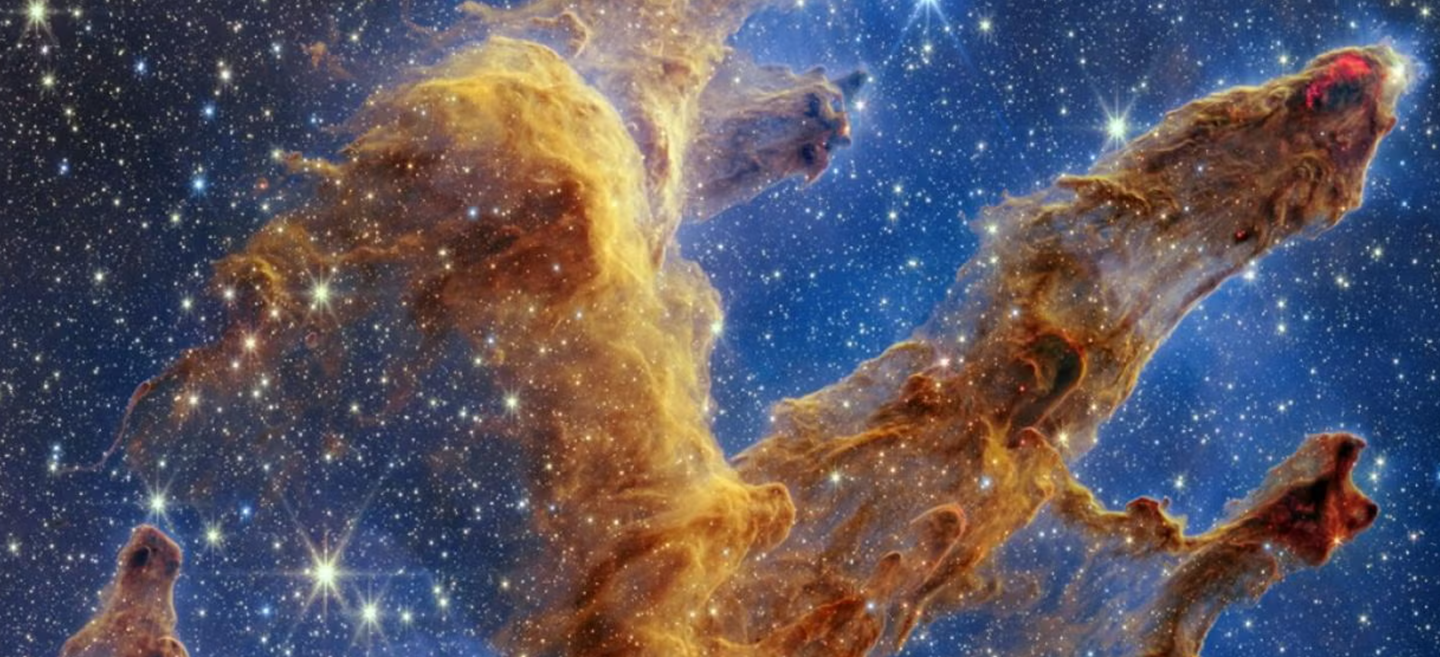Cosmic discovery reveals how mysterious buckyballs form in deep space
A new study shows how intense bursts of energy can twist simple carbon molecules into new shapes, offering clues to the origins of fullerenes in space.

 Edited By: Joseph Shavit
Edited By: Joseph Shavit

“Pillars of Creation,” a region in the Eagle Nebula where clouds of gas and dust are collapsing to form new stars. (CREDIT: NASA, ESA, CSA, STScI; Image Processing: Joseph DePasquale (STScI), Anton Koekemoer (STScI), Alyssa Pagan (STScI))
Far from Earth, drifting between the stars, lies a quiet ocean of carbon. Astronomers call it the interstellar medium, a vast realm where simple and complex molecules float through cold clouds of gas and dust. Among them are polycyclic aromatic hydrocarbons, better known as PAHs. These flat, ringed molecules glow in the infrared when hit with ultraviolet light and may hold nearly one fifth of all cosmic carbon. Their presence shapes the chemistry of young stars, planets and, in time, life.
For years, you may have pictured this molecular family as a diverse crowd with many shapes and sizes. Recent observations challenge that view. Across bright regions in distant galaxies, PAHs reveal nearly the same infrared signatures. Those repeating patterns point to a smaller group of sturdy, symmetric molecules called grandPAHs. Their structure seems strong enough to survive the harsh radiation that destroys other PAHs.
A new study reveals how even small PAHs can completely rearrange themselves when they meet intense energy. The results suggest a possible bridge between PAHs and fullerenes, the spherical carbon cages that float freely through space and resemble tiny soccer balls. The work, led by researchers at the University of Colorado Boulder, adds a fresh layer of understanding to the chemistry that shaped the earliest building blocks of our solar system.
Recreating Harsh Cosmic Conditions in the Lab
Jordy Bouwman, an assistant professor in the Department of Chemistry at CU Boulder and scientist at the Laboratory for Atmospheric and Space Physics, guided the effort. He says the motivation feels personal to anyone curious about the origins of life. “We’re all made of carbon, so it’s really important to know how carbon in the universe gets transformed on its way to being incorporated in a planetary system like our own solar system,” Bouwman said.
The study focused on two small PAHs called anthracene and phenanthrene. These molecules share the formula C14H10 but have different shapes. Both are familiar on Earth. They form when organic material burns, showing up in soot, smoke and the charred crust of food left too long on the grill.
Researchers began by bombarding the molecules with a 30 electron volt beam. This hit them with far more energy than sunlight in space usually provides but served as a way to recreate rare two photon absorption events or the intense bursts of X rays found near young stars and planet forming disks. The electron impact removed hydrogen atoms and produced charged fragments.
Those fragments were placed inside a cryogenic ion trap at the Free Electron Lasers for Infrared eXperiments facility in the Netherlands. There, they were cooled to just a few degrees above absolute zero and tagged with neon atoms. The tags allowed the team to record the infrared fingerprints of each fragment without changing the chemistry. By scanning with bright infrared lasers and comparing the results with quantum chemical calculations, the scientists determined the structures of the new molecules.
A Surprising Shift Toward Symmetry
The team expected each PAH to break into pieces that reflected their original shapes. Instead, the fragments from anthracene and phenanthrene looked almost the same. Their infrared signatures matched closely, dominated by only a few strong vibrational features.
This raised a striking possibility. The molecules appeared to shed hydrogen only after first reshaping themselves into a single, highly stable form. Calculations and experiments pointed to pyracyclene, a charged C14H8 structure marked by two isolated five membered rings. The molecule was much lower in energy than any other possible rearranged form and matched the experimental spectrum almost exactly.
Saturation scans strengthened the case. When the laser targeted major absorption bands, researchers saw that at least 80 percent of the ions behaved consistently with pyracyclene. Only a small fraction showed features of other isomers.
Even the singly dehydrogenated products shared patterns suggesting that two related structures dominated. The findings revealed a natural pathway through which different PAHs can rearrange themselves into nearly identical shapes long before they begin to fall apart.
Tracing the Energy Path
To understand how this happens, researchers mapped parts of the molecules’ potential energy surfaces. These maps show the energetic cost of twisting, folding or breaking a molecular skeleton. The team identified several intermediate states that linked the original PAHs to their final forms through a series of hydrogen shifts. Some of the transitions required more than 70 kilocalories per mole, which is far beyond what sunlight normally provides. Yet the electron beam delivered hundreds of kilocalories per mole of internal energy, more than enough to push the molecules through every step.
Although the lab conditions were extreme, the results match what computer models predict for larger PAHs exposed to ultraviolet radiation or cosmic rays. Over long stretches of time, even modest bursts of energy can add up. PAHs in space can absorb two photons before cooling. They can also meet X rays in protoplanetary disks with energies near 20 electron volts. These events happen slowly but repeatedly, making complex rearrangements through high energy pathways possible.
Why the Findings Matter for Space Chemistry
The discovery strengthens the argument that grandPAHs dominate interstellar infrared emission. The rearranged fragments are symmetric, stable and contain both pentagons and hexagons. These are the same features seen in fullerenes such as buckminsterfullerene (buckyballs). The work supports a long suspected link: that PAHs, once reshaped through radiation, may curl into closed carbon cages.
Fullerenes appear widely in the interstellar medium, yet their origin has been mysterious. Bouwman believes the new results point toward an answer. “This gives us a hint that the buckyballs that we find in space may be connected to these large aromatic molecules that are also abundant,” he said.
These rearranged PAH fragments also carry dipole moments, which means they should reveal themselves in radio surveys. Adding them to spectral databases will help astronomers interpret infrared and microwave observations from clouds where stars and planets form.
Sandra Brünken, a co author from Radboud University and leader at FELIX, sees a clear next step. She hopes astronomers will look for the same molecular fingerprints with the James Webb Space Telescope. “You can take our results from the laboratory, and then use them as a fingerprint to look for the same signatures in space,” Brünken said.
Practical Implications of the Research
This work gives astronomers a better guide for tracking how carbon evolves in space. It highlights a likely pathway connecting PAHs to fullerenes, offering clues to the chemical steps that shaped the earliest material in our solar system. It may also help identify new molecules responsible for mysterious absorption features known as diffuse interstellar bands.
As researchers add these fragment structures to spectral libraries, future observations from telescopes like JWST will become easier to interpret.
Understanding how PAHs break apart and rebuild could also refine models of hydrogen formation in space, which influences how stars ignite and how planets develop.
Research findings are available online in the Journal of the American Chemical Society.
Related Stories
- What space dust can teach us about Earth’s climate history
- Scientists solve the cosmic mystery of missing sulfur in deep space
- Phosphorus from space could help explain the origins of life on Earth
Like these kind of feel good stories? Get The Brighter Side of News' newsletter.
Joshua Shavit
Science & Technology Writer and Editor
Joshua Shavit is a Los Angeles-based science and technology writer with a passion for exploring the breakthroughs shaping the future. As a co-founder of The Brighter Side of News, he focuses on positive and transformative advancements in AI, technology, physics, engineering, robotics and space science. Joshua is currently working towards a Bachelor of Science in Business and Industrial Engineering at the University of California, Berkeley. He combines his academic background with a talent for storytelling, making complex scientific discoveries engaging and accessible. His work highlights the innovators behind the ideas, bringing readers closer to the people driving progress.



